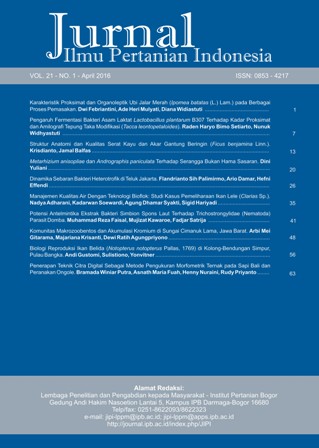Dinamika Sebaran Bakteri Heterotrofik di Teluk Jakarta
Abstract
Jakarta Bay is one of the aquatic ecosystems with the highest level of organic pollution in the world. Ecological condition of Jakarta Bay’s water will affect the ecosystem, including the distribution of heterotrophic bacteria. This study aims to determine the dynamics of the distribution of heterotrophic bacteria in the Jakarta Bay. Sampling was done by 4 repetitions during the year of 2013. Primary and secondary data was used in this research. The results showed an abundance of heterotrophic bacteria fluctuate and are relatively high in the area close to the mouth of the river and decreasing abundance in the ocean. The highest abundance obtained at Station 10 with 3,5 × 106 CFU/ml density and the lowest abundance obtained at Station 1 with 1,8 × 105 CFU/ml density. The highest density obtained in October with an average of 1,3 × 106 CFU/ml and the lowest density obtained in July with the average of 3,5 x 105 CFU/ml. Abundance of heterotrophic bacteria have a close relationship with chlorophyll-aDownloads
References
[APHA] American Publich Health Association. 2005. Standard Methods for the Examination of Water and Wastewater. Washington DC (US): Public Health Association.
Dahuri R, Rais J, Ginting SP, Sitepu MJ. 1996. Pengelolaan Sumber Daya Wilayah Pesisir dan Lautan Secara Terpadu. Jakarta (ID): Pradnya Paamita.
Damar A. 2003. Effects of Enrichment on Nutrient Dynamics, Phytoplankton Dynamics and Productivity in Indonesian Tropical Water: A Comparison Between Jakarta Bay, Lampung Bay, and Semangka Bay. [Dissertation]. Kiel-Germany (DE): Christian-Albrechts-Universität zu Kiel.
Damar A, Colijn F, Hesse KJ, Wardiatno Y. 2012. The eutrophication states of Jakarta, Lampung and Semangka Bays: Nutrient and phytoplankton dynamics in Indonesian tropical waters. Journal of Tropical Biology & Conservation. 9(1): 61-81.
Damar A. 2013. Deteksi Faktor Lingkungan Pemicu Timbulnya Peledakan Populsi Fitoplankton (Red Tide) di Perairan Teluk Jakarta dan Kaitannya dengan Eutrofikasi Perairan Pesisir dan Laut dalam Perspektif Perubhan Iklim Global. Laporan Penelitian Unggulan Lembaga Penelitian dan Pengabdian Kepada Masyarakat-Institut Pertanian Bogor (LPPM-IPB). Bogor (ID).
Effendi H. 2003. Telaah Kualitas Air Bagi Pengelolaan Sumber Daya dan Lingkungan Perairan. Yogyakarta (ID): Kanisius.
Gomes A, Gasol JM, Estrada M, Franco-Vidal L, Diaz-Perez L, Ferrera I, Moran XAG. 2015. Heterotrophic bacterial responses to the winter-spring phytoplankton bloom in open water of the NW Mediterranean. Deep-Sea Research I. 96: 59-68. http://doi.org/bd77
Karrasch B, Mehrens M, Rosenlocher Y, Peters K. 2001. The dunamics of phytoplankton, bacteria and heterotrophic flagellates at two banks near Magdeburg in the River Elbe (Germany). Limnologica. 31(2): 93-107. http://doi.org/fxht6w
Kunarso DH. 1988. Peranan Bakteri Heterotrofik Dalam Ekosistem Laut. Jurnal Oseana. XIII(4): 133-142.
Kunarso DH. 2011. Kajian Kesuburan Ekosistem Perairan Laut Sulawesi Tenggara Berdasarkan Aspek Bakteriologi. Jurnal Ilmu dan Teknologi Kelautan Tropis. 3(2): 32-47.
Nontji A. 2008. Plankton Laut. Jakarta (ID): LIPI Press.
Odum EP. 1971. Dasar-Dasar Ekologi. Edisi ketiga. Yogyakarta (ID): Gadjah Mada University Press.
Pearce I, Davidson AT, Thomson PG, Wright S, Enden Rvd. 2011. Marine microbial ecology in the sub-Antarctic Zone: Rates of bacterial and phytoplankton growth and grazing by heterotrophic protist. Deep-Sea Research II. 58(21-22): 2248-2259. http://doi.org/ffjqtv
Rheinheimer G. 1991. Aquatic Microbiology: 4th Edition. UK: Jhon Wiley and Sons.
Rheinheimer G. 1984. Interrelationship Between Bacterian and Phytoplankton. In Marine du CNRS:101-106.
Ruyitno N. 2007. Distribusi Vertikal Bakteri dan Kaitannya dengan Konsentrasi Klorofil-a di Perairan Kalimantan Timur. Makara Sains. 11(1): 10-15.
Sverdrup KA, Duxbury AC, Duxbury AB. 2009. An Introduction To The World’s Oceans: 10th. New York (US): McGraw-Hill.
Suzuki K, Kuwata A, Yoshie N, Shibata A, Kawanobe K, Saito H. 2011. Population dynamics of phytoplankton, heterotrophic bacteria, and viruses during the spring bloom in the western subartic Pacific. Journal of Deep-Sea Research I. 58(5): 575-589. http://doi.org/fjwcm5
Trivedi R. 2008. Microbial Diversity of Culturable Heterotrophic Bacteria in the Tropical Saline Lake. Department of Microbiology-M.T.B. College Campus (IN).
Vazquez-Dominguez E, Duarte CM, Agusti S, Jurgen K, Vangue D, Gasol JM. 2008. Microbial plankton abundance and heterotrophic activity across the central Atlantic Ocean. Journal Progress in Oceanography. 79(1): 83-94. http://doi.org/bqk63g
This journal is published under the terms of the Creative Commons Attribution-NonCommercial 4.0 International License. Authors who publish with this journal agree to the following terms: Authors retain copyright and grant the journal right of first publication with the work simultaneously licensed under a Creative Commons Attribution-NonCommercial 4.0 International License. Attribution — You must give appropriate credit, provide a link to the license, and indicate if changes were made. You may do so in any reasonable manner, but not in any way that suggests the licensor endorses you or your use. NonCommercial — You may not use the material for commercial purposes.






















